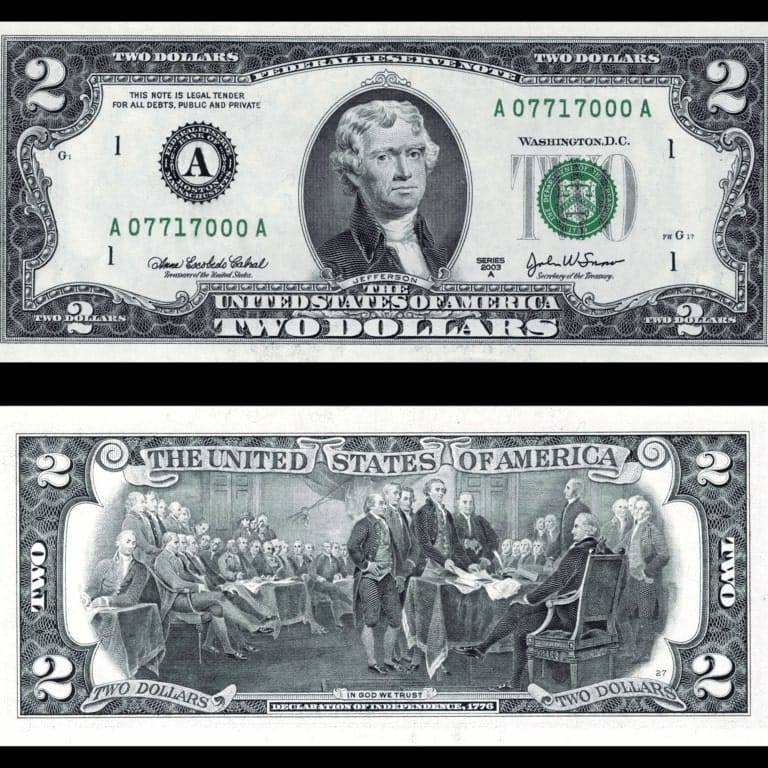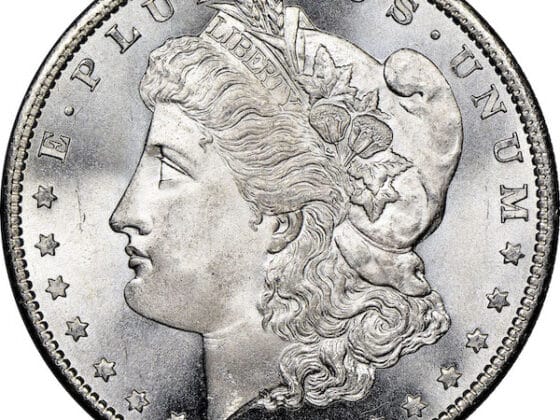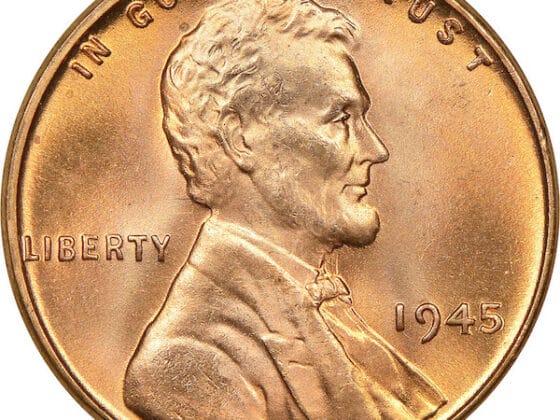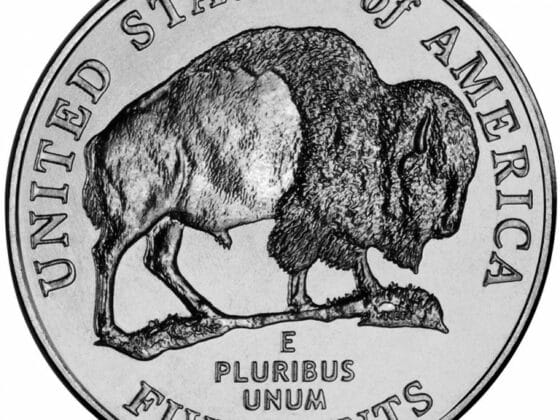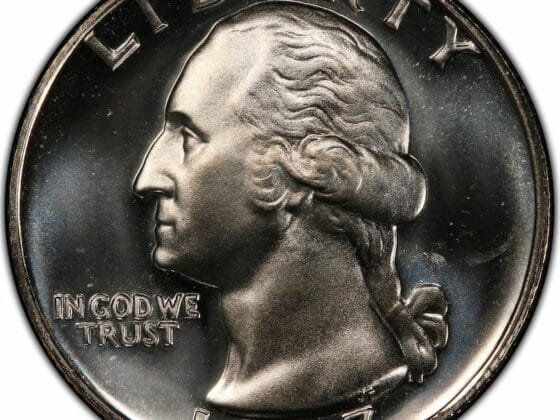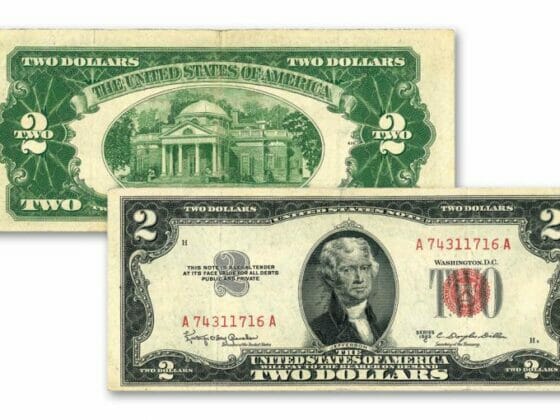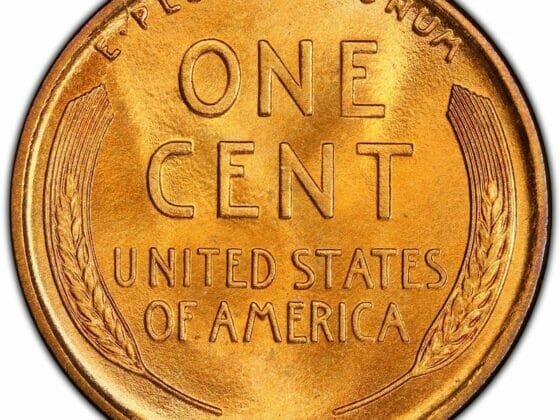1976 marked a pivotal moment in American history, not just for its bicentennial celebration but also for re-introducing a unique and symbolic currency – the $2 bill. It was first printed in 1862, becoming America’s oldest and only commemorative banknote design. The bill comes in various renditions, creating disparity and confusion about its worth. Read on to discover the value, design, and series of the 1976 2-dollar bill.
Table of Contents
History, Printage & Series
The year 1976 marked the United States’ bicentennial, celebrating 200 years after the signing of the Declaration of Independence. The $2 bill, featuring a redesign that captured the essence of American patriotism, was re-introduced to honor this historic event.
Before this reintroduction, the $2 bill had been absent from circulation since its debut in 1862 and reprinted in 1963, making its return in 1976 a significant event. No 1976 2-dollar bills are printed today, as their production ended in 1978. By then, 590,720,000 series 1976 $2 bills were printed.
Despite the Treasury Department printing many $2 bills in late 1976 and 1977, most never circulated. As such, most 2-dollar 1976 bills were never used and are pristine. The only problem with this new bill is that the Federal Reserve issued it during economic hardship. So many were never circulated as people couldn’t afford it. But despite the low circulation, the bill still has some charm that makes it desirable among collectors.
Did You Know?
- The 1976 $2 bill was the first $2 denomination assigned to a Federal Reserve District, leading to 12 different variations based on this distinction.
- Star notes, with their distinctive asterisk, signify rare and valuable replacement bills for misprints or errors.
- Bills printed in Washington, D.C., lack a facility mark, while those from Fort Worth, Texas, bear a small “FW” on the front, indicating their printing origin.
- Series year variations, such as 1976A, 1976B, etc., represent different production runs with unique elements or changes, adding depth to collectors’ pursuits.
The 1976 2-Dollar Bill Designs
Obverse Side
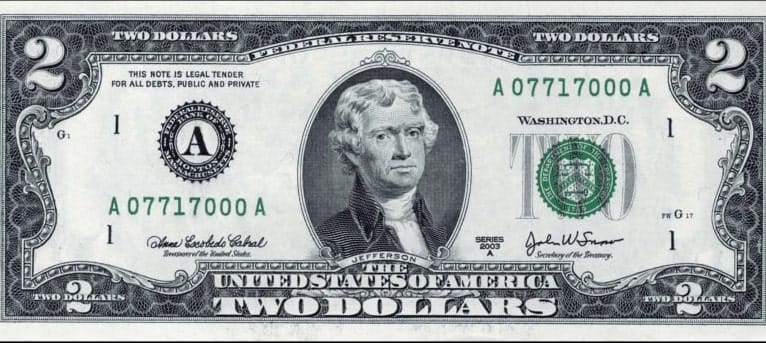
The obverse side of the 1976 $2 bill features the familiar portrait of Thomas Jefferson, the third President of the United States. Jefferson’s image is complemented by intricate engravings and designs, showcasing the attention to detail that characterizes the bill’s overall aesthetic.
Above his image, you’ll find the words “FEDERAL RESERVE NOTE.” The United States Treasury Seal, a Department of the Treasury symbol, is printed in green and appears on the right below “WASHINGTON D.C,” setting it apart from earlier two-dollar bills.
This change made it easily distinguishable and added to its uniqueness. It also encapsulates the spirit of the American Revolution, making the bill more than just a piece of currency—it became a symbol of the nation’s foundation.
Below Jefferson’s portrait, you’ll see “THE UNITED STATES OF AMERICA.” The denomination “TWO DOLLARS,” is prominently displayed along the lower edge in large fonts to emphasize the bill’s value.
You’ll find the green serial number on the right side, a unique combination of letters and numbers that identifies the specific bill. The serial number also appears on the right, just above “WASHINGTON D.C.”
Additionally, the obverse side bears the signatures of two key officials: the Secretary of the Treasury and the Treasurer of the United States. These signatures vary depending on the 1976 series, providing authenticity to the bill and representing the authority of the U.S. government. The digit “2” and the words “TWO DOLLARS” appear four times on the note.
Reverse Side
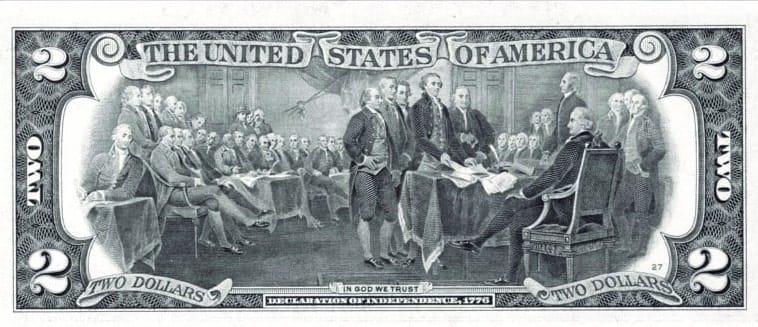
Source: Rarest.org
One of the most captivating features of the 1976 $2 bill is the reverse side, which depicts John Trumbull’s painting “The Declaration of Independence.” This iconic artwork replaced the image of Thomas Jefferson’s house and captured a pivotal moment in American history when the drafting committee presented its work to Congress. The bill beautifully showcases this historic scene, reminding us of America’s birth.
Surrounding the central artwork are ornate filigree and decorative patterns that enhance the bill’s visual appeal. The country’s name, “THE UNITED STATES OF AMERICA,” appears on the banner above the painting.
Below it is the legend “IN GOD WE TRUST,” followed by the phrase “DECLARATION OF INDEPENDENT, 1976.” These are sandwiched by the bill’s denomination in the words “TWO DOLLARS” printed on a banner. The word “TWO” appears on both the right and left sides, and the digit “2” appears four times on the bill’s corners.
Signatures
The 1976 $2 bill boasts the distinctive signatures of two notable figures: Secretary of the Treasury William E. Simon and U.S. Treasurer Francine Irving Neff. These signatures, elegantly inscribed on the bill, not only authenticate the currency but also add a personal touch, connecting the holder directly to the individuals who held significant roles in the U.S. Treasury during that period.
The legacy of the 1976 $2 bill design did not end with its initial issuance. In the years following the Bicentennial celebration, subsequent series were introduced, each retaining the iconic 1976 design. Among these notable series include the 1995 and 2003 editions.
While these later releases did not carry the same historical weight as the original Bicentennial edition, they continued to feature the powerful imagery of Trumbull’s painting on the reverse side and the portraits of Thomas Jefferson and John Adams on the obverse side.
1976 $2 Bill with Stamp
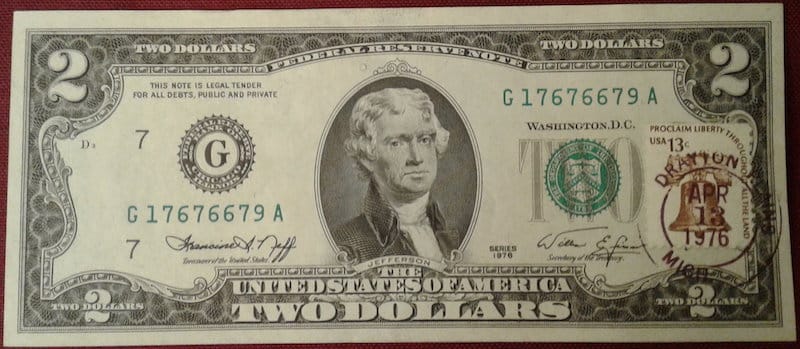
One intriguing aspect of the 1976 $2 bill is the presence of stamp marks, often used as part of the Bicentennial celebrations. Americans who received their first-day issues visited their local post offices to get their bills stamped with the printing date “APR 13, 1976.”
When found on the bill, these stamps mark the day the 1976 notes were first released to the public and commemorate President Thomas Jefferson’s birthday. Such $2 bills are relatively more valuable, especially if the stamps have unique city names.
1976 2-Dollar Bill Value
While some may assume that the 1976 $2 bill is a rare collector’s item, its value may surprise you. Most of these bills are still in circulation, making them relatively common. However, their value can vary based on their condition and series.
A circulated 1976 $2 bill is typically worth its face value, while an uncirculated one is worth $15 or more. Nevertheless, certain aspects like serial numbers and printing errors of this bill can make it a valuable collectible.
For instance, 1976 $2 bills with lower serial numbers can fetch a premium. Those with a printing error are extremely rare and more expensive than others. $2 bills with different serial numbers on the top and bottom are worth $400 in good condition. Uncirculated specimens can fetch about $800.
If it’s a star note, expect $8 in circulated condition. Uncirculated star bills graded MS63 are worth between $20 and $25, and some rare ones sold for $80 to $150.
The Rarity Myth & Collector’s Perspective
The 1976 $2 bill, despite its distinctive design and historical significance, has often been shrouded in misconceptions regarding its rarity and value. One of the prevailing myths is that these bills are scarce, hence their inflated prices in the collector’s market.
However, they were printed in massive numbers during the bicentennial celebration. While not as common as other denominations due to their limited circulation, they are far from scarce.
1976 2 Dollar Bill Star Notes: A Collector’s Gem
One aspect that can significantly increase the value of a 1976 $2 bill is if it’s a star note. Star notes are replacement notes used when a bill has been misprinted or contains errors. These notes are easily identifiable by the star (*) at the beginning or end of the serial number.
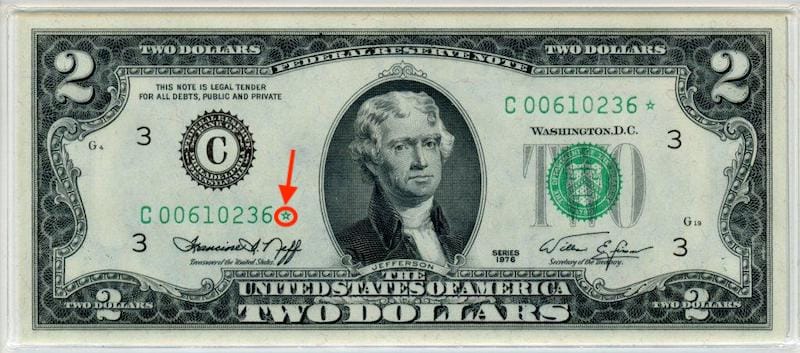
Star notes are relatively scarce compared to regular issues, making them highly coveted by collectors. Due to their limited production, star notes command a premium in the collector’s market, often fetching higher prices than their standard counterparts. One specimen graded by PCGS 64 PPQ was sold for $35,250 at Heritage Auctions in 2016.
PCGS 64 PPQ Definition:
PCGS: This stands for “Professional Coin Grading Service,” which is a reputable third-party grading service for coins and banknotes.
64: This is a numerical grade on a scale typically ranging from 1 to 70, which indicates the condition of the item. In this context, a grade of 64 suggests the bill is in choice uncirculated or near gem quality.
PPQ: This abbreviation stands for “Premium Paper Quality.” It indicates that the paper of the banknote is of superior quality, without any significant impairments.
In summary, “PCGS 64 PPQ” means that the Professional Coin Grading Service has graded a banknote to be in choice uncirculated condition with premium paper quality.
1976 2-Dollar Bill Value Chart
| $2 Bill Type | Circulated Condition | Uncirculated Condition | MS63 Grade | Bills with a Star |
| 1976 2-Dollar Bill with Green Seal | $2 – $10 | $15 | $20 – $25 | $8 |
How much is a 1976 2 Dollar Bill Worth? Mini Summary
The 1976 $2 bill generally holds its face value in circulated condition, but uncirculated bills can be worth $15 or more. Special features, such as low serial numbers or printing errors, can significantly increase its value, with some error bills selling for as much as $35,250 and $2,760, respectively.
1976 2-Dollar Bill Errors
For collectors looking to uncover hidden treasures, 1976 $2 bill errors can be exciting. These errors, caused by various printing mishaps, make specific bills scarce and valuable. Here is a list of some classic errors, how they occur, and their associated values:
Misaligned Printing
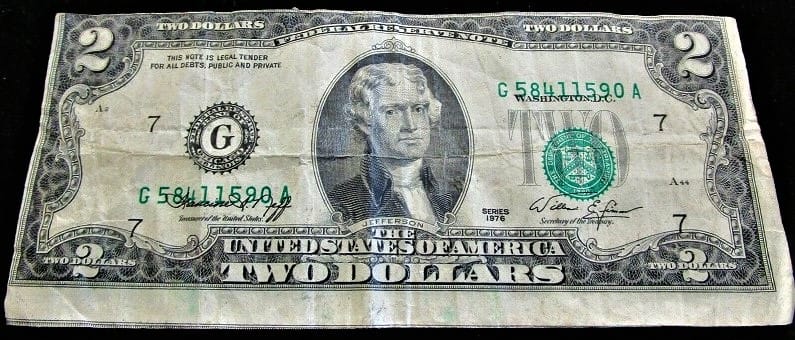
Misaligned printing occurs when the different printing stages fail to align correctly, leading to an offset image or the serial number. Such bills have serial numbers that are different or don’t match.
Depending on the degree of misalignment, these bills can range in value from $5 to several hundred dollars. Such a 1976 $2 bill fetches $500 in average condition, and weight can skyrocket to $900 for those in uncirculated condition.
Inverted Overprint Errors
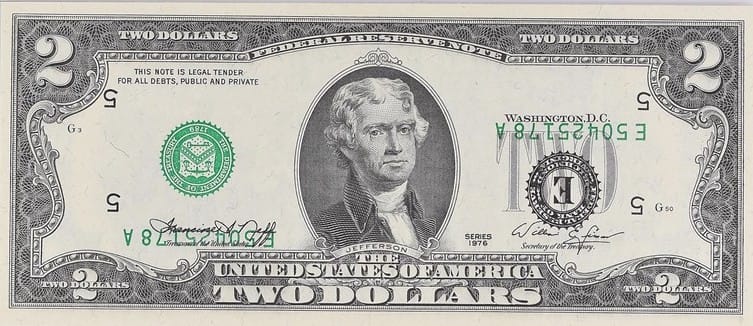
Inverted overprint errors happen when excessive ink is applied during printing, causing the details to blur. Bills with overprint errors are valued based on the extent of blurring, ranging from $10 to $100 or more. Such a bill fetched $2,760 at Heritage Auctions in 2021.
Cutting Errors
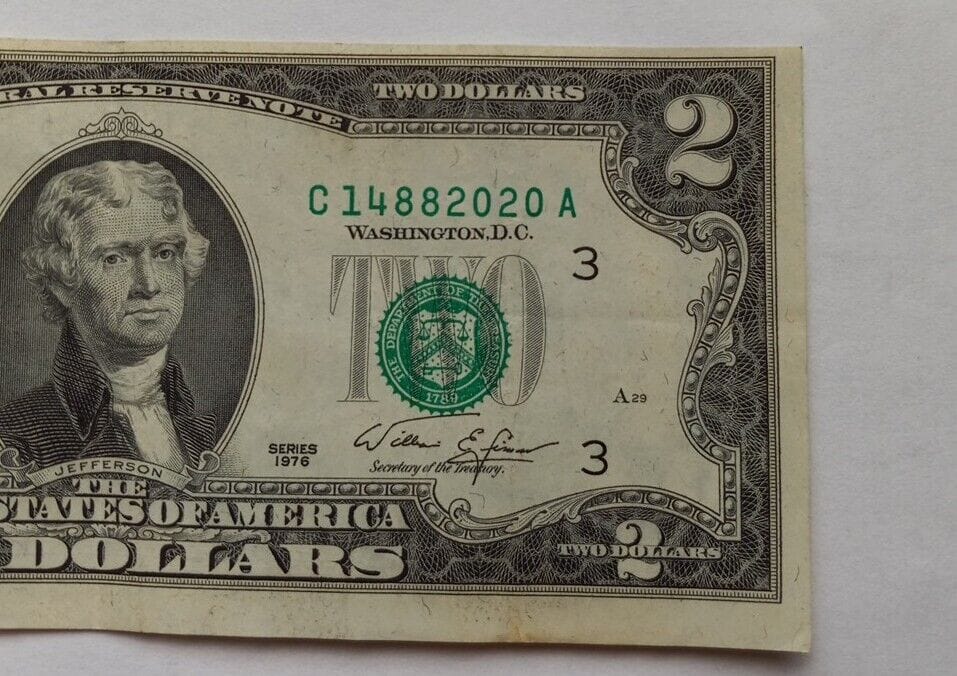
Cutting errors occur when the cutting machinery fails to trim the sheets accurately, leaving irregular edges or corners. Depending on the severity, bills with cutting errors can be valued between $10 and $200.
Related: The 1953 2-Dollar Bill Value, Seal, Series & Design
Conclusion
The 1976 $2 bill is not just a currency but a symbol of American history. It serves as a unique reminder of the United States Bicentennial and features a design that captures a pivotal moment in the nation’s birth. While it may not be as rare as some believe, its collector’s value, particularly for star notes and uncirculated bills, makes it a treasure for those who appreciate the artistry and history behind each bill.
As you hold a 1976 $2 bill, take a moment to appreciate not just its financial worth but the rich story it tells – a story of freedom, democracy, and the enduring legacy of the United States of America.

